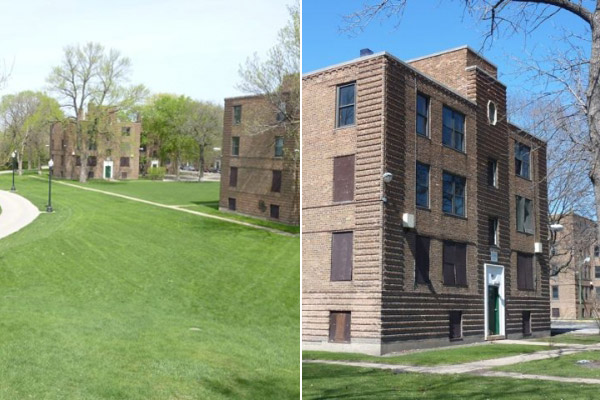
The Chicago Reporter's Angela Caputo has an excellent piece on how 18 percent of CHA units are unoccupied, despite a waiting list of tens of thousands. Some, obviously, have been taken "offline" to be worked on, but Caputo found that the vast majority of offline units are "in litigation," even though the majority of those are not actually involved in a court case. That has to do with the CHA's broad interpretation of HUD rules, which HUD is okay with—despite so many units being tied up in the opaque category of "in litigation," the CHA gets funding for them. As Kimbriell Kelly argues, it means the CHA has no economic reason to fill the units, since collecting rent on an unoccupied unit is a really good deal.
Where are most of those in-litigation units? They're in one of the more admired, and most controversial, CHA developments. Lathrop Homes has long been one of the better-functioning public-housing developments in Chicago and a relative urban-planning success, writes Aaron Renn, in contrast to its neighbor, the unfortunate (if economically successful) mess at Diversey/Damen/Clyborn. Its low-rise design, solid pre-war construction, and landscaping by Jens Jensen make it an appealing location, in contrast to the projects that have defined "public housing."
"What's interesting and ironic is Lathrop Homes, in its current form, is already what CHA's plan for transformation set as its goal in 1999," he said. "They wanted to get rid of the high-rise housing complexes with elevators surrounded by asphalt parking lots. They wanted more green space and a more friendly environment. Lathrop already embodies all of that. It's really beautiful. If it's not broke, don't fix it."
Lathrop also has a place in the community's history, with residents who helped diversify the area and push for change. After the housing complex integrated in the 1960s, it became one of few that retained a diverse mix of residents, McDermott said.
It needs substantial work, but Renn and others think that Lathrop could not only address the city's historic problems with public housing, it could also go against the grain of its historic problems with segregated housing, which undermined so much of the CHA's work:
It’s no secret that Chicago is heavily segregated and balkanized. The pure gentrification wave that was sweeping through the area crashed with the housing market, leaving the Hamlin Park area bordering Lathrop as an interesting pocket of diversity, with an eclectic mix of pretty much at least one of everybody. It reminds me a bit of my old neighborhood in South Evanston – and in a good way. Because of the diverse surroundings and general lack of suspicion of Lathrop by non-residents, I believe there’s an opportunity to achieve something very special here.
Lathrop Homes has been in limbo for years, and as of 2006 was supposed to be torn down and replaced with an apartment-condo-townhome development. But momentum has shifted in recent years, with a historic-place designation earlier this year making the site less likely to be torn down and making the possibility of renewal more financially realistic. Now the battle for Lathrop has shifted to a different conflict—the ratio of public, affordable, and market-rate housing that the future Lathrop development will consist of:
Charles Woodyard, the CHA’s new CEO, stated that the agency may ditch the formula that was supposed to guide much of its redevelopment—reserving one-third of new replacement units for market-rate renters or buyers, another third for affordable housing, and only one-third for public housing.
But Kerry Dickson, the senior vice president of Related Midwest, one of the lead developers of Lathrop Community Partners, the consortium selected in 2010 to lead the Lathrop process, said the site may eventually have an even higher percentage of market-rate units. Nothing has been set, he added, and a lower percentage of market-rate also remains a possibility. “I think it could go either direction.”
Lathrop's physical condition has deteriorated, but it still has the foundation of a model public housing development, if a realistic model of one. Yet 82 percent of its units are offline, almost all of those in the litigation category. According to the CHA last year, that limbo is a big reason:
"There are many units that are not habitable and also, given that we are at the eve of our planning process, it doesn't make sense to invest the resources required to make them habitable in order to move families in because only to have them temporarily move them out," Chou said.
Which is about what Woodyard told the Tribune recently, in an article dealing with similar issues as Caputo:
Charles Woodyard, CEO of the CHA, addressed the need for affordable housing in Chicago in a statement Tuesday but said necessary maintenance is preventing some of the units from housing tenants. Some public housing sites, such as Lathrop Homes and Cabrini Green, are offline temporarily for rehabilitation or closed permanently to make way for new, mixed-income redevelopment, he said.
What remains is an oddity. It's an externally well-maintained, well-designed public-housing project that's almost completely vacant in an area that's bleeding rental units, a model for government-subsidized housing that receives federal subsidies yet houses only 18 percent of what it's designed to do: a reverse Potemkin Village on the shore of the Chicago River.
Related: Dennis Rodkin on the Lathrop Homes, with a good slideshow.
Photographs: Chicago Magazine


